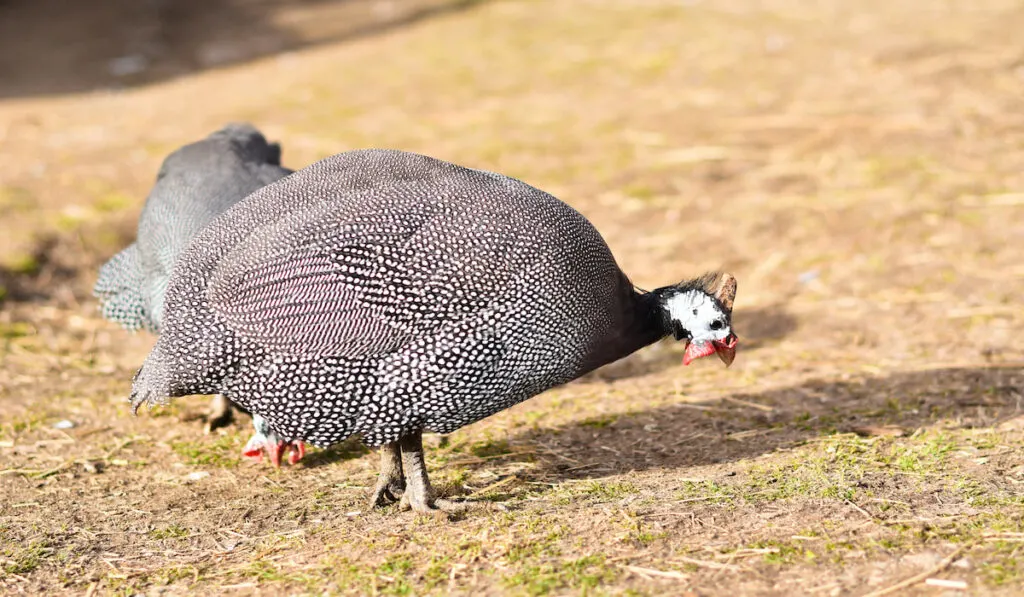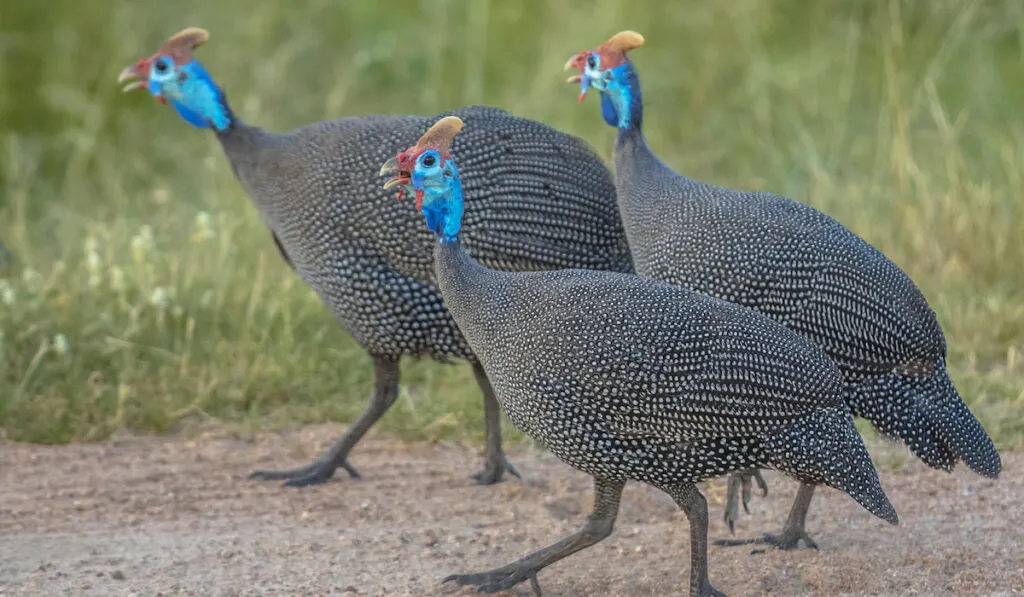Guinea fowl are a great addition to your backyard poultry flock, provided you have the space for them. Guineas are best recommended for people with a lot of open space as they are forager birds and like to free-range and eat small pests.
They can also be quite a noisy and vocal bird, so before deciding on guinea fowl, make sure your neighbors won’t mind.
Guinea fowl are so vocal that some farmers use them as an alarm system.
If you have a small farm, guinea fowl are one of the best hardy poultry breeds you can get. Because they are ranging birds that like to forage, they do not do well in industrial farms.
Because of the guinea fowl’s hardiness and their tendency to feed on pests like ticks, they have become a favorite with small farmers looking for a low-maintenance bird. Guinea fowl are territorial and highly alert and will ward off small predators from other backyard poultry.
If you’re a small farmer looking to include guinea fowl in your flock, I’ll give you a cost breakdown to help you decide whether guinea fowl are for you.

Table of Contents
The Cost of Guinea Fowl Keets, Adults, and Hatching Eggs
Guinea fowl keets, or chicks, cost between $3.20-$6 for the common varieties.
Guinea fowl are foraging birds but need additional food. Keets will need high protein food for development, whereas adult guinea fowl need 16% protein poultry feed. Expect to pay $1.60 on feed a month per adult bird.
Guinea fowl are normally bought as young chicks, known as keets, and raised to adulthood. Most hatcheries in the U.S. will price their keets by number, with a minimum order. For example, one of the most prominent hatcheries specializing in guinea fowl has a minimum keet order of 5 birds.
Buying 1-29 of their White African keets will cost $5 per bird, but if you’re looking at ordering over 120 chicks, the price per bird will work out to $4.45.
It’s best to buy young keets rather than adult birds. Adults cost around $15-$25 a bird, but they are also more likely to fly away if not kept in a covered pen, as they are territorial birds.
Guinea fowl are free-range birds that live almost wild and like to forage across a territory, so you will have to consider space constraints when buying your guinea fowl.
Baby keets are bought unsexed, and the birds make for good meat and egg production. Guinea fowl meat is rich, lean with the taste of wild game. Young guinea fowl meat is more tender.
Once an adult female comes into lay, she can produce roughly an egg a day during the egg-laying season. Guinea hens take longer to reach maturity than chickens – an adult guinea hen takes around a year before she is at the point where she is producing an egg daily. Guinea eggs are usually smaller than chicken eggs, with thicker shells. Take this into consideration with your costing.
If you prefer to hatch guinea fowl eggs yourself and have the necessary means to incubate them for 28 days, you can get hatching eggs for as little as $29.40 for a dozen.

How Much Will It Cost To Keep Guinea Fowl?
One of the best things about guinea fowl is that their hardiness makes them relatively low-maintenance.
Guinea fowl need plenty of space to roam and are excellent birds for keeping down mice, ticks, small snakes, caterpillars, snails, and other small pests. Although these gamebirds are free-range, it’s a very good idea to provide them with some shelter from the elements.
If you’re keeping guineas mainly for meat and egg production rather than pest control and predator alerts, you may prefer to confine them to a large, covered pen.
When planning this coop, you will need to provide a minimum of 2-3 square feet per guinea fowl and 10 square feet of run space. As they are roaming birds, they will become very stressed if kept in a smaller space.
If you are used to keeping chickens, double the space required for chickens to estimate your space needs per bird. For example, if your coop and run previously housed 10 chickens comfortably, it would be suitable for 5 guinea fowl.
Their run or pen will need to be covered as guinea fowl are able fliers. The pen will also need some bedding to absorb their mess. Make sure they have adequate perches, as guineas like to roost. If kept purely outdoors, they will roost in trees, so be sure you have suitable trees established.
When raising guineas for egg production, provide them with nest boxes just as you would chickens. You will also need to provide a container for water supply.
Initial Cost of Setting Up a Coop for Guinea Fowl
If you intend to house your guineas in a coop and run, the cost will vary depending on the materials you use and the number of guinea fowl you intend to keep.
- A large walk-in run for around 10 guinea fowl can cost between $300-$1000
- Nest boxes cost around $5 each.
- Infra-red lamps for raising keets in a brooder cost around $100
- Many farmers raise young keets in large cardboard boxes that they will throw away when they are grown. This can help keep costs down.
- Water containers are needed to provide keets with clean, fresh, warm water. Do not give keets cold water as this can kill them.
- Round wooden perches are essential as guineas need to roost and perch. Branches are perfectly suitable and will cost you very little.

How Much Does It Cost To Feed Guinea Fowl?
When raising young keets, they will need a high protein diet for the first 5-6 weeks of their life. A good game bird starter with at least 28% protein will cover their needs.
The initial game bird starter food will be the most expensive, but it is necessary to get the keets off to a good start and to raise healthy birds.
- Gamebird starter feed costs around $19.99 for a 50lb bag. https://www.tractorsupply.com/tsc/product/purina-game-bird-and-turkey-starter-30-40-lb-3005640-305
From ages 5-8 weeks, you can begin feeding them a 20% protein chicken grower feed.
- 20% protein chick grower feed costs about $19.99 for a 50lb bag. https://www.tractorsupply.com/tsc/product/tractor-supply-dumor-chick-strarter-grower-20-feed-50-lb-3006317-306
From 8 weeks on, you can supplement their foraging with 16% protein chicken layer feed.
- 16% protein chicken layer feed is about $16.99 for a 50lb bag. https://www.tractorsupply.com/tsc/product/tractor-supply-dumor-16-layer-pellet-50-lb-3006319-206
If your guineas do not have free-range to forage, you will need to supply them with extra fresh greens and corn for good digestion.
Always make sure guinea fowl have access to grit and oyster shells to help them digest food and provide calcium for egg-laying.
Conclusion
Guinea fowl make excellent backyard poultry for small farms and can help keep down unwanted pests and provide alarms against predators.
Guineas cost an average of $4-$5 a bird when bought as young keets, and their food costs as an adult are relatively low. Expect to pay less than $2 per bird every month in food costs.
Their meat is considered flavorful, moist, and lean and can be sold at a higher price than chicken meat.
